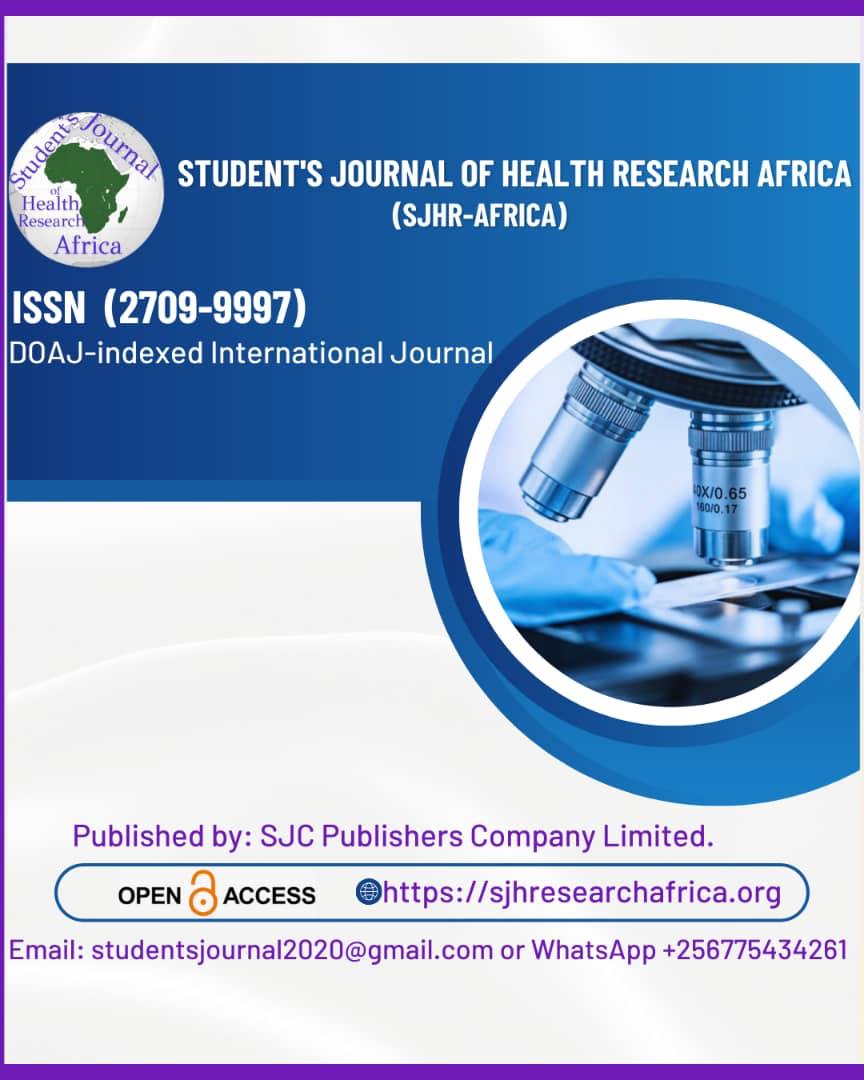Prevalence and factors associated with extra-spousal partnerships among currently married individuals in Rakai, Uganda: A Cross-sectional study.
DOI:
https://doi.org/10.51168/sjhrafrica.v6i6.1795Keywords:
Extra-spousal partnerships, Married individuals, Rakai, UgandaAbstract
Introduction
While extra-marital relations have been associated with increased risk for HIV infection in previous studies, extant literature on the prevalence and factors associated with these sexual relationships remains largely limited. We assessed the prevalence and factors associated with extra-spousal partnerships among currently married individuals.
Methods
This secondary analysis uses data from a large cross-sectional study conducted among married individuals aged 15-49 years in Rakai, Uganda. We used a generic definition of marriage to include all individuals who considered themselves as “married” irrespective of category. Extra-spousal sexual partnerships were defined as concurrent sexual relationships between a married individual and another person (of the opposite sex) with whom they were not currently married. We determined the prevalence of extra-spousal partnerships and used a modified Poisson regression model to assess factors independently associated (at P<0.05) with extra-spousal partnerships, after adjusting for potential confounders. We used STATA (version 14.0) for data analysis.
Results
Of 2,103 currently married individuals, 51.5% (n=1,084) were females; 66.1% (n=1,391) were in their first marriage ever, while 83.3% (n=1,751) had been married for five or more (5+) years. Thirteen per cent (n=282) reported extra-spousal partnerships; 4.5% (n=49) among females and 22.9% (n=233) among males. Being HIV-positive, being in the third or higher marital order marriage, engagement in housework (among women), and being male were significantly associated with engaging in extra-spousal partnerships. Being 35 years or older was protective against engaging in extra-spousal partnerships.
Conclusion
One in ten currently married individuals engaged in extra-spousal partnerships. Extra-spousal partnerships were more common among men, individuals living with HIV, those with a higher number of previous marriages, and women engaged in housework than their counterparts.
Recommendations
Targeted HIV prevention interventions, including those that focus on men and previously married individuals, are urgently needed to protect married individuals from the risk of extra-spousal partnerships.
References
Abdulazeez, A., Alo, E. & Naphthali, R. (2008). Concurrent Infection Of HIV-1 and HIV-2 Serotypes in Adamawa State, Nigeria. World Journal of Medical Science, 3, 15-18
Auerbach, J. D., Parkhurst, J. O., & Cáceres, C. F. (2011). Addressing social drivers of HIV/AIDS for the long-term response: conceptual and methodological considerations. Global Public Health, 6 Suppl 3, S293–S309. https://doi.org/10.1080/17441692.2011.594451
Beauclair, R., Hens, N., & Delva, W. (2015). Concurrent partnerships in Cape Town, South Africa: race and sex differences in prevalence and duration of overlap. Journal of the International AIDS Society, 18(1), 19372. https://doi.org/10.7448/IAS.18.1.19372
Camlin, C.S., Kwena, Z.A., Dworkin, S.L. (2013). Jaboya vs. jakambi: Status, negotiation, and HIV risks among female migrants in the "sex for fish" economy in Nyanza Province, Kenya. AIDS Education and Prevention, 25(3), 216-31
Carpenter, L. M., Kamali, A., Ruberantwari, A., Malamba, S. S., & Whitworth, J. A. (1999). Rates of HIV-1 transmission within marriage in rural Uganda according to the HIV sero-status of the partners. AIDS, 13(9), 1083–1089. https://doi.org/10.1097/00002030-199906180-00012
Chang, L. W., Grabowski, M. K., Ssekubugu, R., Nalugoda, F., Kigozi, G., Nantume, B., et al. (2016). Heterogeneity of the HIV epidemic in agrarian, trading, and fishing communities in Rakai, Uganda: an observational epidemiological study. Lancet HIV, 3(8), e388–e396. https://doi.org/10.1016/S2352-3018(16)30034-0
Clark, S., Kabiru, C., & Zulu, E. (2011). Do men and women report their sexual partnerships differently? Evidence from Kisumu, Kenya. International Perspectives on Sexual and Reproductive Health, 37(4), 181–190. https://doi.org/10.1363/3718111
Dunkle, K. L., Stephenson, R., Karita, E., Chomba, E., Kayitenkore, K., Vwalika, C., et al. (2008). New heterosexually transmitted HIV infections in married or cohabiting couples in urban Zambia and Rwanda: an analysis of survey and clinical data. Lancet, 371(9631), 2183–2191. https://doi.org/10.1016/S0140-6736(08)60953-8
Filippone, P. L., Hernandez Trejo, Y., & Witte, S. S. (2023). Demonstrating the Feasibility of an Economic Empowerment and Health Promotion Intervention among Low-Income Women Affected by HIV in New York City. International Journal of Environmental Research and Public Health, 20(8), 5511. https://doi.org/10.3390/ijerph20085511
Genberg, B. L., Kulich, M., Kawichai, S., Modiba, P., Chingono, A., Kilonzo, G. P., et al. (2008). HIV risk behaviors in sub-Saharan Africa and Northern Thailand: baseline behavioral data from Project Accept. Journal of Acquired Immune Deficiency Syndromes, 49(3), 309–319. https://doi.org/10.1097/QAI.0b013e3181893ed0
Ghana Statistical Service (GSS) and ICF. 2024. Ghana Demographic and Health Survey 2022. Accra, Ghana, and Rockville, Maryland, USA: GSS and ICF. Available at: https://dhsprogram.com/pubs/pdf/FR387/FR387.pdf. Accessed on June 22, 2025.
Grabowski, M. K., Reynolds, S. J., Kagaayi, J., Gray, R. H., Clarke, W., Chang, L. W., et al. (2018). The validity of self-reported antiretroviral use in persons living with HIV: a population-based study. AIDS, 32(3), 363–369. https://doi.org/10.1097/QAD.0000000000001706
Guthrie, B. L., de Bruyn, G., & Farquhar, C. (2007). HIV-1-discordant couples in sub-Saharan Africa: explanations and implications for high rates of discordancy. Current HIV Research, 5(4), 416–429. https://doi.org/10.2174/157016207781023992
Kagaayi, J., Chang, L. W., Ssempijja, V., Grabowski, M. K., Ssekubugu, R., Nakigozi, G., et al. (2019). Impact of combination HIV interventions on HIV incidence in hyperendemic fishing communities in Uganda: a prospective cohort study. Lancet HIV, 6(10), e680–e687. https://doi.org/10.1016/S2352-3018(19)30190-0
Kaiser, R., Bunnell, R., Hightower, A., Kim, A. A., Cherutich, P., Mwangi, M., et al. (2011). Factors associated with HIV infection in married or cohabiting couples in Kenya: results from a nationally representative study. PLoS One, 6(3), e17842. https://doi.org/10.1371/journal.pone.0017842
Kasamba, I., Sully, E., Weiss, H. A., Baisley, K., & Maher, D. (2011). Extraspousal partnerships in a community in rural Uganda with high HIV prevalence: a cross-sectional population-based study using linked spousal data. Journal of Acquired Immune Deficiency Syndromes, 58(1), 108–114. https://doi.org/10.1097/QAI.0b013e318227af4d
Kwena, Z., Mwanzo, I., Shisanya, C., Camlin, C., Turan, J., Achiro, L., et al. (2014). Predictors of extra-marital partnerships among women married to fishermen along Lake Victoria in Kisumu County, Kenya. PLoS One, 9(4), e95298. https://doi.org/10.1371/journal.pone.0095298
Kwena, Z. A., Shisanya, C. A., Bukusi, E. A., Turan, J. M., Dworkin, S. L., Rota, G. A., et al. (2017). Jaboya ("Sex for Fish"): A Qualitative Analysis of Contextual Risk Factors for Extramarital Partnerships in the Fishing Communities in Western Kenya. Archives of Sexual Behavior, 46(7), 1877–1890. https://doi.org/10.1007/s10508-016-0930-0
Labrecque, L. T., & Whisman, M. A. (2017). Attitudes toward and prevalence of extramarital sex and descriptions of extramarital partners in the 21st century. Journal of Family Psychology: JFP: Journal of the Division of Family Psychology of the American Psychological Association (Division 43), 31(7), 952–957. https://doi.org/10.1037/fam0000280
Maher, D., Waswa, L., Karabarinde, A., & Baisley, K. (2011). Concurrent sexual partnerships and associated factors: a cross-sectional population-based survey in a rural community in Africa with a generalised HIV epidemic. BMC Public Health, 11, 651. https://doi.org/10.1186/1471-2458-11-651
Matovu, J. K., Todd, J., Wanyenze, R.K., Kairania, R., Serwadda, D., & Wabwire-Mangen, F. (2016). Evaluation of a demand-creation intervention for couples' HIV testing services among married or cohabiting individuals in Rakai, Uganda: a cluster-randomized intervention trial. BMC Infectious Diseases, 16, 379. https://doi.org/10.1186/s12879-016-1720-y
Matovu, J. K., Todd, J., Wanyenze, R.K., Wabwire-Mangen, F., & Serwadda, D. (2015). Correlates of previous couples' HIV counseling and testing uptake among married individuals in three HIV prevalence strata in Rakai, Uganda. Global Health Action, 8, 27935. https://doi.org/10.3402/gha.v8.27935
McCreesh, N., OʼBrien, K., Nsubuga, R. N., Shafer, L. A., Bakker, R., Seeley, J., et al. (2012). Exploring the potential impact of a reduction in partnership concurrency on HIV incidence in rural Uganda: a modeling study. Sexually Transmitted Diseases, 39(6), 407–413. https://doi.org/10.1097/OLQ.0b013e318254c84a
Meekers, D. (1992). The process of marriage in African societies: A multiple indicator approach. Population and Development Review, 18(1), 61-78
Mishra, V. & Assche, S., B-V. (2009). Concurrent Sexual Partnerships and HIV Infection: Evidence from National Population-Based Surveys. DHS Working Papers No. 62. Calverton, Maryland: Macro International Inc. Available at: https://www.dhsprogram.com/pubs/pdf/wp62/wp62.pdf. Accessed on May 7, 2025.
Mishra, V., Medley, A., Hong, R., Gu, Y., Robey, B. (2009). Levels and Spread of HIV Seroprevalence and Associated Factors: Evidence from National Household Surveys. DHS Comparative Reports No. 22. Calverton, Maryland, USA: Macro International Inc. Available at: https://www.dhsprogram.com/pubs/pdf/CR22/CR22.pdf. Accessed May 8, 2025.
Mitchell, K. R., Mercer, C. H., Prah, P., Clifton, S., Tanton, C., Wellings, K., et al. (2019). Why Do Men Report More Opposite-Sex Sexual Partners Than Women? Analysis of the Gender Discrepancy in a British National Probability Survey. Journal of Sex Research, 56(1), 1–8. https://doi.org/10.1080/00224499.2018.1481193
Mtenga, S. M., Pfeiffer, C., Merten, S., Mamdani, M., Exavery, A., Haafkens, J., et al. (2015). Prevalence and social drivers of HIV among married and cohabiting heterosexual adults in south-eastern Tanzania: analysis of adult health community cohort data. Global Health Action, 8, 28941. https://doi.org/10.3402/gha.v8.28941
Mtenga, S. M., Pfeiffer, C., Tanner, M., Geubbels, E., & Merten, S. (2018). Linking gender, extramarital affairs, and HIV: a mixed methods study on contextual determinants of extramarital affairs in rural Tanzania. AIDS Research and Therapy, 15(1), 12. https://doi.org/10.1186/s12981-018-0199-6
Nabukenya, A. M., Nambuusi, A., & Matovu, J. K. B. (2020). Risk factors for HIV infection among married couples in Rakai, Uganda: a cross-sectional study. BMC Infectious Diseases, 20(1), 198. https://doi.org/10.1186/s12879-020-4924-0
Nnko, S., Boerma, J. T., Urassa, M., Mwaluko, G., & Zaba, B. (2004). Secretive females or swaggering males? An assessment of the quality of sexual partnership reporting in rural Tanzania. Social Science & Medicine (1982), 59(2), 299–310. https://doi.org/10.1016/j.socscimed.2003.10.031
Salia, J. G., Sidat, M., Dias, S. F., Martins, M. R. O., & Craveiro, I. (2020). High Mobility and STIs/HIV among Women Informal Cross-Border Traders in Southern Mozambique: Exploring Knowledge, Risk Perception, and Sexual Behaviors. International journal of environmental research and public health, 17(13), 4724. https://doi.org/10.3390/ijerph17134724
Shisana, O., Rehle, T., Simbayi, L.C., Zuma, K., Jooste, S., Zungu, N., Labadarios, D., Onoya, D. et al. (2014). South African National HIV Prevalence, Incidence and Behaviour Survey, 2012. Cape Town, HSRC Press. Available at: https://hsrc.ac.za/uploads/pageContent/4565/SABSSM%20IV%20LEO%20final.pdf. Accessed on May 5, 2025.
Shukla, M., Agarwal, M., Singh, J. V., Tripathi, A. K., Srivastava, A. K., & Singh, V. K. (2016). High-risk sexual behavior among people living with HIV/AIDS attending tertiary care hospitals in the district of Northern India. Indian Journal of Sexually Transmitted Diseases and AIDS, 37(1), 46–51. https://doi.org/10.4103/0253-7184.176212
Smolak, A. (2014). A meta-analysis and systematic review of HIV risk behavior among fishermen. AIDS Care, 26(3), 282–291. https://doi.org/10.1080/09540121.2013.824541
Todd, J., Cremin, I., McGrath, N., Bwanika, J. B., Wringe, A., Marston, M., et al. (2009). Reported number of sexual partners: comparison of data from four African longitudinal studies. Sexually Transmitted Infections, 85 Suppl 1(Suppl_1), i72–i80. https://doi.org/10.1136/sti.2008.033985
Uganda Bureau of Statistics (UBOS). (2023). Uganda Demographic and Health Survey 2022. Kampala, Uganda: UBOS. Available at: https://www.ubos.org/wp-content/uploads/publications/UDHS-2022-Report.pdf. Accessed on May 12, 2025.
UNAIDS Reference Group on Estimates, Modelling, and Projections: Working Group on Measuring Concurrent Sexual Partnerships. (2010). HIV: consensus indicators are needed for concurrency. Lancet, 375(9715), 621–622. https://doi.org/10.1016/S0140-6736(09)62040-7
Wawer, M. J., Gray, R. H., Sewankambo, N. K., Serwadda, D., Paxton, L., Berkley, S., et al. (1998). A randomized, community trial of intensive sexually transmitted disease control for AIDS prevention, Rakai, Uganda. AIDS, 12(10), 1211–1225. https://doi.org/10.1097/00002030-199810000-00014
WHO. 2024. HIV and AIDS [Online]. Geneva: Switzerland; World Health Organization. Available at: https://www.who.int/News-Room/Fact-Sheets/Detail/Hiv-Aids. Accessed May 9, 2025.
Wondemagegn, F., & Berkessa, T. (2020). High-level risky sexual behavior among persons living with HIV in the urban setting of the highest HIV prevalent areas in Ethiopia: Implications for interventions. PLoS One, 15(11), e0242701. https://doi.org/10.1371/journal.pone.0242701
Zambia Statistics Agency, Ministry of Health (MoH) [Zambia], and ICF. 2024. Zambia Demographic and Health Survey 2024: Key Indicators Report. Lusaka, Zambia, and Rockville, Maryland, USA: Zambia Statistics Agency, MoH, and ICF. Available at: https://dhsprogram.com/pubs/pdf/PR159/PR159.pdf. Accessed on June 22, 2025.
Zimbabwe National Statistics Agency (ZIMSTAT) and ICF. Zimbabwe Demographic and Health Survey 2023 24: Key Indicators Report. Harare, Zimbabwe, and Rockville, Maryland, USA: ZIMSTAT and ICF. Available at: https://dhsprogram.com/pubs/pdf/PR160/PR160.pdf. Accessed on June 22, 2025.
Downloads
Published
How to Cite
Issue
Section
License
Copyright (c) 2025 Joseph KB Matovu, Arnold Tigaiza

This work is licensed under a Creative Commons Attribution-NonCommercial-NoDerivatives 4.0 International License.






















